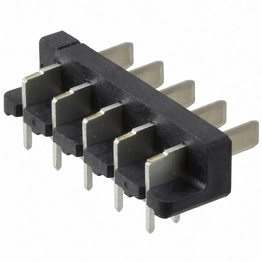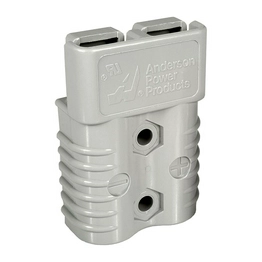Power Connectors
Power Connectors are electrical devices that facilitate the transmission of power from one component to another within a system. They are crucial for maintaining the flow of electricity in various applications, ensuring the safe and efficient transfer of energy.
Definition:
Power connectors are specialized electrical connectors designed to handle high current and voltage loads. They are engineered to provide a robust and reliable connection, often in environments where power delivery is critical.
Function:
1. Transmission of Power: They transfer electrical power from a power source to devices or systems.
2. Safety: They include safety features to prevent electrical shock and ensure the protection of users and equipment.
3. Reliability: They are built to withstand repeated connections and disconnections without loss of performance.
4. Efficiency: They minimize power loss during transmission, ensuring maximum energy utilization.
Applications:
1. Automotive: Used in electric vehicles for charging and internal power distribution.
2. Industrial: Employed in machinery and equipment for power supply and control.
3. : Vital for systems where reliability and durability are paramount.
4. Renewable Energy: Essential in solar panels and wind turbines for efficient power transfer.
5. Data Centers: Used for connecting servers and other equipment to ensure uninterrupted power supply.
Selection Criteria:
1. Current Rating: Choose connectors that can handle the maximum current your system requires.
2. Voltage Rating: Ensure the connectors can withstand the voltage levels in your application.
3. Contact Material: Look for connectors with high-quality contact materials to minimize resistance and corrosion.
4. Environmental Resistance: Consider connectors that can operate in the specific environmental conditions of your application (e.g., temperature, humidity, dust).
5. Mechanical Strength: Select connectors with robust construction to withstand physical stress and vibrations.
6. Certifications: Ensure the connectors meet industry standards and safety certifications relevant to your region or industry.
7. Ease of Use: Consider the ease of installation, maintenance, and the compatibility with existing systems.
In summary, power connectors are essential for the reliable and efficient transfer of electrical power in a wide range of applications. When selecting power connectors, it's important to consider their current and voltage ratings, material quality, environmental resistance, mechanical strength, certifications, and ease of use to ensure they meet the specific needs of your system.
Please refer to the product rule book for details.
Definition:
Power connectors are specialized electrical connectors designed to handle high current and voltage loads. They are engineered to provide a robust and reliable connection, often in environments where power delivery is critical.
Function:
1. Transmission of Power: They transfer electrical power from a power source to devices or systems.
2. Safety: They include safety features to prevent electrical shock and ensure the protection of users and equipment.
3. Reliability: They are built to withstand repeated connections and disconnections without loss of performance.
4. Efficiency: They minimize power loss during transmission, ensuring maximum energy utilization.
Applications:
1. Automotive: Used in electric vehicles for charging and internal power distribution.
2. Industrial: Employed in machinery and equipment for power supply and control.
3. : Vital for systems where reliability and durability are paramount.
4. Renewable Energy: Essential in solar panels and wind turbines for efficient power transfer.
5. Data Centers: Used for connecting servers and other equipment to ensure uninterrupted power supply.
Selection Criteria:
1. Current Rating: Choose connectors that can handle the maximum current your system requires.
2. Voltage Rating: Ensure the connectors can withstand the voltage levels in your application.
3. Contact Material: Look for connectors with high-quality contact materials to minimize resistance and corrosion.
4. Environmental Resistance: Consider connectors that can operate in the specific environmental conditions of your application (e.g., temperature, humidity, dust).
5. Mechanical Strength: Select connectors with robust construction to withstand physical stress and vibrations.
6. Certifications: Ensure the connectors meet industry standards and safety certifications relevant to your region or industry.
7. Ease of Use: Consider the ease of installation, maintenance, and the compatibility with existing systems.
In summary, power connectors are essential for the reliable and efficient transfer of electrical power in a wide range of applications. When selecting power connectors, it's important to consider their current and voltage ratings, material quality, environmental resistance, mechanical strength, certifications, and ease of use to ensure they meet the specific needs of your system.
Please refer to the product rule book for details.
Categories
Datasheets
Article

Polar Capacitors: Types,Polarity Guide,Testing & Applications
Table of Contents + 1.What Are Polar Capacitors? 1.1.How Polar Capacitors Work 1.2.Structure & Dielectric 1.3.Common types 1.3.1.Aluminium Electrolytic Capacitor 1.3.2.Tantalum Electrolytic Capacitors 1.3.3.Supercapacitor2.Polar vs Non-Polar Capacitors 2.1.Key Differences 2.2.When to use polar capacitors 2.3.Equivale...
Learn More >

10k Ohm Resistor Color Code Explained: 4-Band, 5-Band, SMD Markings & Uses
Table of Contents + 1. Why 10k is the most used Resistor2. What is a 10k Ohm Resistor? Definition and Parameter Comparison3. What is the color code for a 10k resistor? 3.1. Common four-band and five-band specifications correspond to the following parameters 3.2. Quick Color Band Reference Chart (Including 10Ω vs. 10kΩ Comparison)4. How to Read Resistor Color Bands? A Technique Even Beginners...
Learn More >

Pull Down Circuit: What It Does, How to Choose Resistor Values & Practical Design Tips
Table of Contents + 1.Pull-down Circuit — Definition & Purpose 1.1.What is a pull-down circuit? 1.2.What Does a Pull-Down Circuit Do? 1.3.Pull-up vs Pull-down — Key Differences 1.4.When to Use Pull-Down vs Pull-Up(Design Criteria) 2.Choosing Pull-down Resistor Values 2.1.Theory: Leakage, Logic Thresholds & RC Time Constant 2.1.1.Formulae & Example C...
Learn More >
























